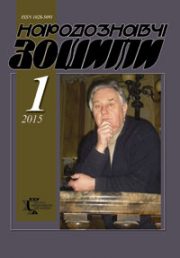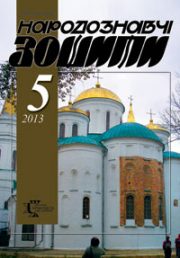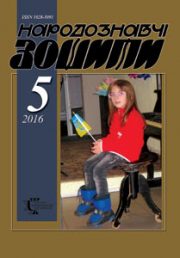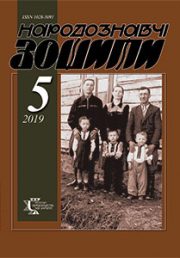The Ethnology Notebooks. 2021. № 5 (161), 1150—1166
UDK 391+677.076.62(477)
DOI https://doi.org/10.15407/nz2021.05.1150
EMBROIDERY ON UKRAINIAN CLOTHES: THE PROBLEM OF ORIGINS
BALUSHOK Vasyl
- ORCID ID: https://orcid.org/0000-0003-1362-8270
- PhD in History, Senior Research Fellow,
- Maksym Rylskyi Institute of Art Studies, Folklore Studies and Ethnology,
- National Academy of Sciences of Ukraine
- 4, Hrushevskoho str., 01001, Kyiv, Ukraine,
- Contacts: e-mail: grigras@i.ua
OLIYNYK Maryna
- ORCID ID: https://orcid.org/0000-0002-2946-8243
- PhD in History, Research Fellow,
- Maksym Rylskyi Institute of Art Studies, Folklore Studies and Ethnology,
- National Academy of Sciences of Ukraine
- 4, Hrushevskoho str., 01001, Kyiv, Ukraine,
- Contacts: e-mail: marina.oliynik@gmail.com
Abstract. Introduction. Genesis of Ukrainian traditional Clothing Embroidery cannot be considered as adequately studied subject. Due to the lack of acceptable Sources, it’s Prehistory since have multiple Gaps, and the Statements made in Literature do not rely on the solid factual Framework. Study Purpose: The purpose of this Study is to outline hypothetical directions of Ukrainian traditional Clothing Embroidery during the earliest stages by considering Timeline, circumstances, Factors and Drivers of its development process. Study Methods are based on study of ornament genesis and evolution regularities, as well as the effects of the cultural borrowing mechanisms described by F. Boas, A. Kroeber, L. Sternberg and S. Arutyunov. Results. General regularities of ornamental genesis suggest that the traditional clothing embroidery of Ukrainian ancestors originates from the pictograms that carry a ritual and philosophical meaning accessible for entire community and embedded into original decoration patterns. Furthermore, currently the exact evolution patterns, i. e., from fabric ornaments to embroidery, or otherwise, still remain unclear. Based on the similarities of ornament origins on various items (including clothing embroidery), it is suggested to track its genesis on the cultural artifacts following two major directions of Ukrainian national culture development: Slavic (superstrate) and Sarmatian (substrate). It is also important to consider various ethnic additions (adstrat) and influences by Classical and the Oriental civilizations. There are clear evidences of clothing embroidery household use incidence among the nations directly involved in the Ukrainian ethno genesis — the Sarmatians (burial grounds, I century AD), the Huns (records by Priscus of Panium, V century AD), the Slavs during Rus’ development age (burial sites in Chorna Mohyla and Shestovytsia, X century AD); moreover, new evidences keep emerging, including, but not limited to statues from the Martynivka Treasure, VII century AD that are still a topic of active discussions. Conclusion. The history of Ukrainian traditional clothing embroidery supposedly dates back to the pre-historic period, probably the Bronze Age — the early Iron Age. Its evolution up to Kyivan Rus’ era may be generally tracked after I century AD, including the relevant evidences from V, VII (somewhat hypothetical) and Х centuries AD
Keywords: embroidery, ornament, pattern, borrowing, archeological culture.
Received 27.09.2021
REFERENСES
- Balushok, V. Oliynyk, M. (2021). Embroidery on the clothes of Ukrainians: some problems of modern discourse. The Ethnology notebooks, 4 (160), 849—863 [in Ukrainian].
- Balushok, V. (2007). Ukrainian ethnic Community: Ethnogenesis, History, Ethnonymy. Bila Tserkva [in Ukrainian].
- Vovk., Khv., & Sripnik, H. (Ed.). (2012). Characteristic Features of South Russian Folk Ornaments. Ethnographic Heritage of Khvedor Vovk (Vol. 1, рр. 106—107). Kyiv [in Ukrainian].
- Niederle, L. (1924). Life and Culture of the Ancient Slavs [in Russian].
- Savitsky, P. (1914, June 13). About Ukrainian Embroidery of the 18th Century and its modern Revival. Chernihiv Zemstvo Week, 24, 1—5 [in Russian].
- Fechner, M.V., & Nedoshivina, N.G. (Ed.). (1993). Old Russian Gold Embroidery X—XIII Centuries. in the Collection of the State Historical Museum. Medieval antiquities of Eastern Europe (Рр. 3—21). Moscow [in Russian].
- Stel’mashchuk, H.H. (2006). Ancient Clothes in Volyn. Lutsk [in Ukrainian].
- Shcheglova, O.A. (2010). The Mystery of «Dancing Men» and «Traces of unseen Animals». Anthropo- and zoomorphic Images in early Slavic Metal-Plastic. Slavic-Russian Jewelry Business and its Origins. Materials of the International Scientific Conference dedicated to the 100th anniversary of the birth of G.F. Korzukhina, St. Petersburg, April 10—16, 2006 (Рp. 146—171). St. Petersburg [in Russian].
- Mihajlov, K. (2007). Early examples of Old Russian Gold Embroidery from Chernigov and Shestovitsa. Chernihiv in the medieval and early modern History of Central and Eastern Europe. Collection of scientific Works dedicated to the 1100th anniversary of the first chronicle mention of Chernihiv (Рр. 138—153). Chernihiv [in Russian].
- Kara-Vasyl’ieva, T. (2008). History of Ukrainian Embroidery. Kyiv [in Ukrainian].
- Kosmina, O.Ju. (2011). Ukrainian Shirt: from Linen to ethnic Symbol. Fashion and Design: historical Experience — new Technologies. Materials of the XIVth International Scientific Conference, St. Petersburg, June 27—30, 2011 (Рр. 370—373). St. Petersburg [in Russian].
- Interview Grubnik, L. with O. Kosmina: Symbolism of Ukrainian Embroideries: Ethnologist revealed the Meaning of Ornaments and Colors. Retrieved from: https://fakty.com.ua/ua/ukraine/20200521-symvolika-ukrayinskyh-vyshyvanok-etnolog-rozkryla-znachennya-ornamentiv-i-koloriv/ (Last accessed: 28.09.2020) [in Ukrainian].
- Akhmedov, I. (2018). Matrices from the Collection of K.I. Ol’shevskij The North Caucasian group of Early Medieval imprinted decorations. «To make a fairy’s whistle from a briar rose». Studies presented to Eszter Istvbnovits on her sixtieth birthday (Рp. 505—528).
- Kosmina, O. Zaporozhye Cossacks carried not Sirwal, but narrow linen Trousers. Retrieved from: https://www.istpravda.com.ua/articles/2020/03/2/157122/ (Last accessed: 28.09.2020) [in Ukrainian].
- Papakin, A. (2020). «Historical Zhupan… Cossack Trousers»: pseudo-Cossack elements of Military Clothing of the Ukrainian Armed Formations of 1917—1921. Striy. Historic Clothing Studies, 2 (Part 2, pp. 43—63) [in Ukrainian].
- Rudenko, O. About trousers. Retrieved from: https://dvka.com.ua/%D0%BF%D1%80%D0%BE-%D1%88%D0%B0%D1%80%D0%BE%D0%B2%D0%B0%D1%80%D0%B8/ (Last accessed: 18.03.2021) [in Ukrainian].
- Rakhno, K. (2020). What were the Clothes of the People of Ukraine: mentions of Trousers in written Sources of the Rіch Pospolytа of the XVI Century. Man, Society, Power in ancient and early modern Ukraine: Contexts of Historical Presentation (Рр. 317—324). Kyiv [in Ukrainian].
- Pakhl’ovs’ka, O. (2001). Ukrainian Postmodernism as Cloning without rules («The Situation of Postmodernism in Ukraine»: Round Table, Kyiv Mohyla Academy, Kyiv, 11.09.2001). Cinema-Theater, 6 (38), 2—6 [in Ukrainian].
- Boas, F. (1927). Primitive Art. Oslo (Harv. Univ. Press).
- Kroeber, A.L. (1901, April-June). Decorative symbolism of the Arapaho. American Antropologist, 3, 308—336.
- Sternberg, L.Ya. (1931). Ornament of Deer Hair and Porcupine Needles. To the Methodology of Studying Ornament. Soviet Ethnography, 3—4, 103—125 [in Russian].
- Arutiunov, S.A. (1989). Peoples and Cultures: their Development and Interaction. Moscow [in Russian].
- Feest, C. F. (2004). Franz Boas, Primitive Art, and the Anthropology of Art. European Review of Native American Studies, 1 (Vol. 18, pp. 5—8).
- Simchenko, Ju.B. (1963). Nganasan Ornaments. Soviet Ethnography, 3, 166—171 [in Russian].
- Sokolova, Z.P. (1982). Travel to Ugra. Moscow [in Russian].
- Zeniskevich, G.I. (1987). Athapaskans of Alaska. Essays on Material and Spiritual Culture. Late 18th — early 19th Century. Leningrad [in Russian].
- Nikonorova, E.E (1998). Ornament of Counting Embroidery of the Bashkirs: Genesis and Development. Abstract Dis. … Candidate of Historical Sciences. Ufa [in Russian].
- Titoreva, G.T. (2004). Artistic Features of the Ornamental Art of the Nanais. Abstract Dis. … Candidate of Art History. St. Petersburg [in Russian].
- Geijer, A. (1938). Birka III. The textile Finds from the Graves. Uppsala [in German].
- Hensel, W. (1967). Poland a Thousand Years Ago (Ed. 3 Completed). Wroclaw; Warsaw; Krakow [in Polish].
- Desrosiers, S., & Rast-Eicher, A. Luxorios Merovingian Textiles Excavated from Burials in the Saint Denis Basilica, France in the 6th—7th Century. Retrieved from: https://www.researchgate.net/publication/301224237_Luxurious_Merovingian_Textiles_Excavated_from_Burials_in_the_Saint_Denis_Basilica_France_in_the_6th-7th_Century (Last accessed: 24.09.2020).
- Daim, F., & Andrasi, J. and other (Eds.). (2000). The Avars on the Edge of the Byzantine World: Studies in Diplomacy, Trade, and Technology Transfer in the Early Middle Ages. Innsbruck [in German].
- Rabinovich, M.G. (Ed.). (1986). Old Russian Clothing of the 9th—13th Centuries. Ancient Clothing of the Peoples of Eastern Europe. Materials for the Historical and Ethnographic Atlas (Рр. 40—62). Moscow [in Russian].
- Spanaki, Yu.A. (2007). Peasant Embroidery of the North-West of Russia in the late 19th — early 20th Centuries in Interior Decoration items. Abstract Dis. … Сandidate of Art History. St. Petersburg [in Russian].
- Smilyanskaya, E.B. (2003). Magicians. Blasphemers. Heretics. Popular Religiosity and «Spiritual Crimes» in Russia in the 18th Century. Moscow [in Russian].
- Balushok, V., & Shevchuk, T. (2020). Swears and Self-Plights of the Ukrainians in Medieval and Early Modern Periods. Folk Art and Ethnology, 4, 54—65 [in Ukrainian].
- Sosenko, K. (1928). Cultural and historical figure of the Old Ukrainian holidays of Christmas and Generous Evening. Lviv [in Ukrainian].
- Osadcha, V.M. (2011). Ritual singing of Slobozhanshchyna: textbook. Kharkiv [in Ukrainian].
- Stasov, V. (1872). Russian Folk Ornament (Issue I: Sewing, Fabrics, Lace). St. Petersburg [in Russian].
- Selivachev, M.R. (2005). Lexicon of Ukrainian ornamentation (iconography, nomination, stylistics, typology). Kyiv [in Ukrainian].
- Linnus, H. (1955). Embroidery in Estonian Folk Art (Vol. 1: Northern Estonia and the islands). Tallinn [in Russian and Estonian].
- Miller, A., & Uvarova, P.S. (Ed.). (1911). Lotus in Little Russian Ornament. Proceedings of the IV Archaeological Congress in Chernigov, 1908 (Vol. ІІІ, pр. 81—88). Moscow [in Russian].
- Spaska, E., & Skripnik, H. (Ed.). (2015). Ethnographic and Art Studies. Kyiv [in Ukrainian].
- Tyshchenko, O.R. (1992). History of Decorative and Applied Art of Ukraine (XIII—XVIII Centuries): Textbook. Kyiv [in Ukrainian].
- Stepanova, Yu.V., Elkina, I.I., Wagner, M., & Tarasov, P. E. (3 eds.). (2019). Embroidery in Old Russian Costume of the 11th—13th Centuries: Place, Meaning, Ornament. The Art of Аncient Textiles. Study Methods, Preservation, Reconstruction. Proceedings of the Russian-German Seminar, Moscow, March 11—13, 2018 (Pp. 270—289). Moscow [in Russian].
- Novyts’ka, M.O. (1965). Gold Embroidery in Kyivan Rus’ (According to Excavations in the USSR). Archeology (Vol. XVIII, pp. 24—38) [in Ukrainian].
- Zaichenko, V. (2015). Embroidery of a Cossack Sergeant of the XVII—XVIII Сenturies from the Collection of the Chernihiv Historical Museum named after V.V. Tarnovsky. Kyiv [in Ukrainian].
- Janisz, M. Painted with Needle and Thread. The History of Embroidery in Outline. Retrieved from: https://docplayer.pl/6424221-Igla-i-nicia-malowane-historia-haftu-w-zarysie.html (Last accessed: 24.09.2020) [in Polish].
- Nikishenko, Yu.I., & Pustovalov, S.Zh. (2012). About an Origin of an Ornament and early Stages of its Development. Scientific Notes of NaUKMA. Theory and History of Culture (Vol. 127, pp. 54—60) [in Ukrainian].
- Klochko, L., & Strokova, L. (2006). Fabrics in Kyivan Rus’ (based on the Collection of the National Museum of History of Ukraine). Sights of Ukraine, 3, 12—17 [in Ukrainian].
- Ostjak Embroidery. (1921). With the Reproduction of an Autochrome Photograph, 4 Photographs and 31 Color Lithographs. Budapest [in German].
- Prilipko, J. (1971). Ukrainian Folk Clothing as a Source for Studying Ethnic History. Folk Art and Ethnography, 5, 10—19 [in Ukrainian].
- Sveshnikov, I.K., & Braichevska, O.A. (1990). Leather Shoes from Zvenyhorod Halytsky. Archeology, 3, 122—129 [in Ukrainian].
- Saburova, M.A., Kolchin, B.A., & Makarova, T.I. (2 eds.). (1997). Footwear. Ancient Rus’. Life and Culture (Рp. 103—105). Moscow [in Russian].
- Artemenko, I.I. (Еd.). (1985). Archeology of the Ukrainian SSR: in 3 vol. Vol. 1: Primitive archeology. Kyiv [in Russian].
- Gavrilyuk, N.O. (Ed.). (1996). Dictionary-Reference Book on Archeology. Kyiv [in Ukrainian].
- Skripnik, G. (Еd.). (2008). History of Ukrainian Art: in 5 vol. (Vol. 1: Art of Primitive Times and the Ancient World). Kyiv [in Ukrainian].
- Skripnik, G. (Еd.). (2010). History of Ukrainian Art: in 5 vol. (Vol. 2: Art of the Middle Ages). Kyiv [in Ukrainian].
- Kazakevich, G. (2010). Celts in the Lands of Ukraine: archaeological, linguistic and cultural Heritage. Kyiv [in Ukrainian].
- Pachkova, S.P. (1999). Participation of the incoming Component in the Formation of Zarubynets Culture. Archeology, 4, 24—41 [in Ukrainian].
- Pachkova, S.P. (2002). Funeral Rite of Zarubynets Culture in the Middle Dnieper. Archeology, 3, 27—39 [in Ukrainian].
- Kagan, Yu.M., & Knabe, G.S. (Ed.). (1988). About Latin Words for clothing. Life and History in Antiquity (Рp. 127—142). Moscow [in Russian].
- Baran, V.D. (1998). Ancient Slavs. Kyiv [in Ukrainian].
- Prykhodniuk, O.M. (2005). Pastyr settlement. Kyiv; Chernivtsi [in Ukrainian].
- Drachuk, V.S. (1975). Systems of Signs in the Northern Black Sea Areas: Emblem-Type Signs in the North Pontic Provinces of the Graeco-Roman World. Kyiv [in Russian].
- Kovpanenko, G.T. (1986). Sarmatian Burial of the 1st Century AD on the Southern Bug. Kyiv [in Russian].
- Yolkina, A.K. (1986). On Fabrics and Gold Embroidery from Sokolova Mogila. In Kovpanenko G.T. Sarmatian Burial of the 1st Century AD on the Southern Bug (Pp. 132—135). Kyiv [in Russian].
- Kurchatov, S.I., Symonenko, O.V., & Chirkov, A.Y. (1995). Sarmatian military. Cemetery on the Middle Prut. Archeology, 1, 112—123 [in Ukrainian].
- Fialko, E.E. (2015). Amazons in Time and Space. Archeology and ancient history of Ukraine, 4 (17), 46—99 [in Russian].
- Klochko, L.S, & Vasina, Z.O. (2017). Dressing of Scythians based on Materials from the Melitopol Mound. Archeology and Ancient History of Ukraine, 2 (23), 152—165 [in Ukrainian].
- Kravchenko, O.V., & Sinitsa, E.V. (2005). Sarmatian Burial from Khmilna Hamlet. Problems of Archeology of the Middle Dnieper. To the 15th anniversary of the Foundation of the Fastiv State Museum of Local Lore (Pp. 270—281). Kyiv; Fastiv [in Ukrainian].
- Sinitsa, E. (2013). Once again about the Relationship between the Sarmatians and the Bearers of Zarubynets Archaeological Culture. Ethnic History of the Peoples of Europe, 40, 14—20 [in Ukrainian].
- Novoseltsev, A.P. (1990). Khazar State and its Role in the History of Eastern Europe and the Caucasus. Moscow [in Russian].
- Petrovsky, M.N. (Ed.). (1946). Priskus of Panium describes the Byzantine Embassy to Attila (448 AD). History of Ukraine in Documents and Materials. Vol. 1: Kyivan Rus’ and Feudal Principalities of the XII—XIII Centuries (Рp. 19—26). Kyiv [in Ukrainian].
- Latyshev, V.V. (1948) Proceedings of ancient Writers about Scythia and the Caucasus. (Part 1: Greek Writers). Bulletin of Ancient History, 4, 225—298 [in Russian].
- Dindorf, L.A. (Ed.). (1870). Historici Graeci Minores. Lipsiae: In aedibus B.G. Teubneri, 1870. [ancient Greek].
- Kozak, D.N. (1995). Cultural and historical Interpretation of the Treasures of Volhynia at the Turn of the IV—V Centuries. Archeology, 4, 50—65 [in Ukrainian].
- Sukhobokov, O. (2003). To the Origins of the History of early Contacts of the Turkic and Slavic Ethnic Groups in the Left Bank of Ukraine. Eastern World, 1, 85—93 [in Ukrainian].
- Prykhodniuk, O. (2001). The Steppe Population of Ukraine and the Eastern Slavs (second Half of the First Millennium AD). Kyiv; Chernivtsi [in Ukrainian].
- Vitaliy, Lyaska (interview): Truth and Fiction about Ukrainian Embroidered Shirts. Oksana Kosmina on the History of Embroidered Clothes. Retrieved from: https://zaxid.net/pravda_i_vigadki_pro_ukrayinski_vishivanki_n1509141. (Last accessed: 03.04.2021) [in Ukrainian].
- Komar, A.V., Kubyshev, A.I., & Orlov, R.S., & Evglevsky, A.V. (Ed.). (2006). Burials of Nomads of the 6th—7th Centuries from the North-Western Azov Region. The Steppes of Europe in the Middle Ages. T. 5: Khazar Time (Pp. 245—374). Donetsk [in Russian].
- Skyba, A. (2012). Zoomorphic Motifs of the VII Century Slavic Repoussage. Researches of the Fine Arts, 4, 58—77.
- The Vцlsunga saga. (1997). The Roots of Yggdrasil. Translated from Old Icelandic by Ya.B. Yarkho. Moscow. Retrieved from: https://ae-lib.org.ua/texts-c/_volsunga_saga__ru.htm. (Last accessed: 05.06.2021) [in Russian].







